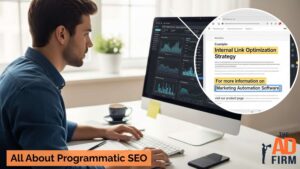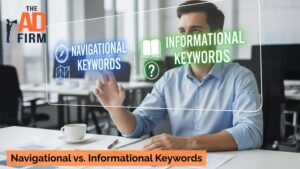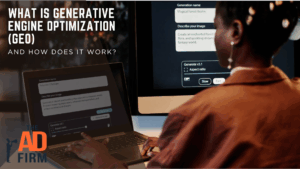PPC advertising is a powerful way to drive targeted traffic and generate leads, but many businesses fail to maximize its potential. Even well-funded campaigns can struggle if key elements are overlooked.
Ad spending is wasted on irrelevant clicks without proper optimization, and conversion rates suffer. This guide breaks down five critical factors that could be hurting your PPC ad performance and provides actionable insights to fix them.
1. Ineffective Keyword Targeting is Wasting Your Budget
Keyword selection is the foundation of a successful PPC campaign. Choosing the wrong keywords or failing to refine targeting leads to wasted ad spend, low engagement, and minimal conversions.
If your ads attract the wrong audience, you’re likely paying for clicks that don’t translate into leads or sales. The key to maximizing PPC efficiency is targeting high-intent keywords while filtering out irrelevant traffic.
Finding High-Intent Keywords That Convert
Broad keywords often lead to wasted ad spend. Instead, focus on commercial and transactional intent keywords—terms that indicate users are ready to take action.
- Long-tail keywords: To attract more qualified leads, instead of “email marketing software,” use “affordable email marketing software for startups.”
- Competitor-based keywords: Bidding on “alternative to [competitor]” positions your brand as a direct option for users interested in similar services.
- Location-based keywords: If serving a specific area, “PPC agency in Los Angeles” performs better than a generic term like “PPC agency.”
- Transactional modifiers: Words like “buy,” “get a quote,” or “best price” signal purchase intent, improving conversion rates.
Prioritizing high-intent keywords ensures ads reach users most likely to convert, leading to better campaign efficiency and ROI.
The Importance of Long-Tail and Negative Keywords
Long-tail and negative keywords are essential for refining PPC targeting. Long-tail keywords focus on specific search intent, increasing the chances of conversion. Instead of broad terms like “marketing software,” “affordable email marketing software for startups” attracts more relevant users.
Negative keywords prevent wasted ad spend by filtering out unqualified traffic. For example, a PPC agency targeting enterprise clients should block searches like “free PPC software” or “cheap PPC consultants.” An eCommerce PPC management campaign for luxury fashion should exclude “budget handbags” or “cheap sunglasses.”
Elevate Your Market Presence with The Ad Firm
- SEO: Boost your search engine visibility and supercharge your sales figures with strategic SEO.
- PPC: Target and capture your ideal customers through highly optimized PPC campaigns.
- Social Media: Engage effectively with your audience and build brand loyalty through targeted social media strategies.
Regular search term reviews help identify low-converting searches. If a keyword generates clicks but not conversions, adding it to the negative list prevents unnecessary spending. Location-based exclusions also matter— a Los Angeles PPC agency should block searches for “PPC agency in New York” to avoid irrelevant leads.
2. Weak Ad Copy Fails to Capture Attention and Drive Action
Your ad copy determines whether users engage with your ad or scroll past it. A well-crafted ad should instantly communicate its value, align with search intent, and encourage action. However, many PPC ads fail because they:
- Lack a clear, unique selling proposition (USP)—users don’t see a compelling reason to choose your business.
- Fail to create urgency, resulting in missed conversion opportunities.
- Have misaligned messaging, causing users to land on irrelevant pages or bounce without taking action.
When an ad doesn’t effectively engage its target audience, it leads to low click-through rates (CTR) and poor return on ad spend (ROAS). Optimizing your ad copy ensures higher engagement, better conversions, and reduced wasted clicks.
Creating a Strong Call-to-Action (CTA) That Converts
Even the best-written ad won’t generate conversions if it lacks a compelling call-to-action (CTA). The CTA tells the user precisely what to do next, whether it’s signing up, purchasing, or booking a consultation. Weak CTAs confuse users or fail to motivate action, leading to high bounce rates and low conversion rates.
How to Write High-Converting CTAs
- Make It Action-Oriented
- Weak CTA: “Learn More” → Too vague.
- Strong CTA: “Get a Free SEO Audit Now!” → tells the user what they’ll receive.
- Be Specific
- Instead of “Contact Us”, try “Schedule a Free Consultation with Our WordPress SEO Experts.”
- Instead of “Improve Your PPC Results”, try “Boost CTR by 50%—Start Your PPC Strategy Today.”
- Create Urgency
- CTAs like “Act Now—Limited Slots Available” encourage users to take action immediately.
- “Get 20% Off Today Only—Claim Your Spot!” leverages time sensitivity.
A well-crafted CTA eliminates hesitation and guides users toward conversion. Combined with strong ad copy and a well-matched landing page, it ensures your PPC ads drive more qualified leads and sales.
Amplify Your Market Strategy with The Ad Firm
- PPC: Master the art of pay-per-click advertising to drive meaningful and measurable results.
- SEO: Elevate your visibility on search engines to attract more targeted traffic to your site.
- Content Marketing: Develop and implement a content marketing strategy that enhances brand recognition and customer engagement.
3. Neglecting A/B Testing Means Missed Opportunities
Many businesses assume that the hardest part is over once they launch a PPC campaign. They set their bids, create ad copy, and let the ads run. However, without continuous testing, even the best campaigns can underperform. A/B testing, also known as split testing, is essential for optimizing PPC performance. It allows advertisers to experiment with different ad variations to identify which elements drive more clicks, higher engagement, and better conversions.
Testing is not just about minor tweaks. It’s about gathering valuable data on how users respond to headlines, descriptions, calls-to-action (CTAs), and ad formats. When businesses fail to test, they rely on assumptions instead of complex data, which often results in wasted budgets and missed revenue opportunities.
A well-structured A/B testing process refines ad performance over time, helping businesses lower costs while increasing ROI. It provides insights into:
- Which headline resonates most with the audience?
- What description encourages users to take action?
- How do different CTAs impact engagement?
- Whether ad extensions improve visibility and clicks.
A data-driven approach ensures continuous improvement, giving businesses a competitive edge in PPC advertising.
Testing Headlines, Descriptions, and CTAs for Higher Click-Through Rates
Small changes in wording can lead to significant differences in PPC performance. The headline and description are the first things users see in an ad, making them essential in capturing attention and driving action. The ad will be ignored if the messaging doesn’t align with user intent or fails to communicate value.
How to Optimize Headlines Through A/B Testing
A compelling headline should be:
- Clear and specific – Avoid vague statements. Be direct about what you offer.
- Action-oriented – Use strong verbs to encourage engagement.
- Keyword-rich – Include relevant search terms to improve relevance.
For example, a WordPress SEO expert testing different headlines may compare:
- “Rank Higher with WordPress SEO Experts – Free Consultation”
- “Get More Traffic – Best SEO Agency for WordPress Sites”
The first headline focuses on expertise and offers consultation, while the second emphasizes traffic growth. Testing helps determine which drives more clicks and leads.
Streamline Your Digital Assets with The Ad Firm
- Web Development: Build and manage high-performing digital platforms that enhance your business operations.
- SEO: Leverage advanced SEO strategies to significantly improve your search engine rankings.
- PPC: Craft and execute PPC campaigns that ensure high engagement and superior ROI.
Experimenting with Ad Formats and Extensions
A/B testing is not limited to text changes. The format and structure of an ad also influence performance. Google Ads provides different ad formats and extensions that impact visibility, engagement, and click-through rates. Testing these elements helps businesses identify which formats drive more conversions.
Why Ad Format Testing is Essential
Google Ads provides various ad formats, each designed to meet specific marketing objectives. Responsive Search Ads (RSAs) adjust dynamically based on user searches, Expanded Text Ads offer complete control over messaging, and Display Ads visually engage audiences across the Google Display Network.
A business offering eCommerce SEO services might find that RSAs drive higher engagement by adapting to search queries, while Display Ads are more effective for retargeting past visitors. Testing multiple formats ensures businesses maximize ad reach, improve engagement, and optimize conversions.
4. Poor Landing Page Experience Leads to High Bounce Rates
A PPC campaign doesn’t end when a user clicks an ad; it continues onto the landing page. If the landing page fails to meet user expectations, ad spend is wasted. When visitors leave immediately after clicking, it signals a mismatch between the ad and the landing page, resulting in low engagement, poor conversion rates, and higher ad costs.
Common landing page issues that drive users away include:
- Mismatched messaging: Users will feel misled if an ad promises “50% Off,” but the landing page doesn’t emphasize the same deal.
- Slow load times: Pages that take more than three seconds to load cause frustration, leading to abandonment.
- Cluttered design: Too many elements—text, images, and buttons—distract visitors from taking action.
A high-performing landing page should be clear, fast, and conversion-focused. If users can’t immediately find what they came for, they will leave, and your ad investment will be wasted.
Ensuring Ad Consistency with Landing Pages
For a seamless user experience, the landing page must immediately reflect the ad’s promise, intent, and tone. Users should instantly recognize that they are in the right place, reinforcing trust and engagement.
A disconnect between the ad and landing page can create confusion, leading to higher bounce rates and missed conversions. Ensuring consistency in messaging, visuals, and offers keeps visitors engaged and encourages them to take action.
Enhance Your Brand Visibility with The Ad Firm
- SEO: Enhance your online presence with our advanced SEO tactics designed for long-term success.
- Content Marketing: Tell your brand’s story through compelling content that engages and retains customers.
- Web Design: Design visually appealing and user-friendly websites that stand out in your industry.
How to Maintain Ad and Landing Page Consistency:
- Mirror the ad’s offer and message: If your ad promotes “50% Off,” this should be the first thing users see on the landing page. Reinforce it with compelling subheadings and visuals.
- Keep the tone and branding uniform: The ad’s tone, language, and visual style should seamlessly transition into the landing page. A PPC ad with an exciting, bold call to action should not lead to a page with bland, generic text.
- Reinforce key selling points: If the ad mentions “Free Consultation” or “Expert PPC Management,” these must be restated on the landing page to remind visitors why they clicked.
Landing pages that immediately validate the user’s decision to click will keep visitors engaged and increase the likelihood of conversion.
Optimizing for Speed, Mobile, and UX for Better Conversions
No matter how well-targeted your PPC campaign is, a slow, unresponsive, or confusing landing page will drive users away.
- Speed Optimization to Minimize Drop-OffsPage speed directly impacts user engagement and Quality Score, influencing both rankings and cost-per-click (CPC). Slow-loading pages frustrate users, increasing abandonment rates.
Optimizing images, reducing excessive scripts, enabling caching, and using a content delivery network (CDN) can dramatically improve load times. A landing page that loads in under three seconds ensures a frictionless experience, keeping users on the page longer.
- Mobile Optimization for Seamless AccessibilityWith over 50% of PPC traffic coming from mobile devices, a fully responsive design is essential. Ensuring pages adjust fluidly to different screen sizes, using intuitive navigation, and optimizing CTA buttons for touchscreens improve user interaction. Readable fonts, concise content, and fast-loading elements create a mobile-friendly experience that drives conversions.
- Enhancing UX to Guide Users Toward ActionA well-structured landing page eliminates friction, making it easier for users to convert. A clutter-free design, strategic use of white space, and clearly defined call-to-action buttons help guide visitors toward the next step. Reinforcing credibility with testimonials, trust badges, and secure checkout signals fosters confidence, reducing hesitation and boosting conversion rates.
5. Lack of Conversion Tracking Leaves You in the Dark
A well-structured PPC campaign is only as good as its data. Without proper conversion tracking, businesses operate blindly, spending money on ads without knowing which drives sales, leads, or sign-ups.
Advance Your Digital Reach with The Ad Firm
- Local SEO: Dominate your local market and attract more customers with targeted local SEO strategies.
- PPC: Use precise PPC management to draw high-quality traffic and boost your leads effectively.
- Content Marketing: Create and distribute valuable, relevant content that captivates your audience and builds authority.
Conversion tracking provides critical insights into user behavior, ad effectiveness, and return on investment (ROI). Without it, businesses:
- Waste ad spend on ineffective campaigns.
- Determine which keywords, ads, and landing pages contribute to conversions.
- Miss opportunities to refine targeting and improve performance.
Setting up accurate tracking ensures that every dollar spent is accounted for and optimized for maximum returns.
Analyzing Data to Improve Future PPC Campaigns
Tracking conversions is only the first step—what matters is how you use the data to refine your campaigns. Regularly analyzing PPC metrics ensures your budget is spent efficiently, helping to maximize returns and eliminate wasted ad spend. By identifying performance trends, advertisers can adjust bids, refine targeting, and optimize ad creatives for better results.
Key PPC Metrics That Drive Optimization
- Click-Through Rate (CTR): A strong CTR indicates that your ad resonates with your audience, while a low CTR suggests poor targeting or weak ad copy.
- Cost-per-Conversion (CPC): High CPC can signal inefficiencies in bidding strategy, requiring adjustments to targeting or ad quality.
- Bounce Rate: A high bounce rate suggests misaligned expectations between the ad and landing page, signaling a need for better messaging or design.
- Conversion Rate: A low conversion rate means the landing page, offer, or user experience may need adjustments to improve results.
Using data-driven insights ensures that PPC campaigns evolve and improve with each iteration. Businesses that actively refine their strategy based on performance metrics can reduce costs, increase ROI, and stay ahead of competitors.
Fix These PPC Mistakes to Boost Performance
PPC success isn’t about increasing ad spend but smarter, more strategic execution. If your campaigns are draining your budget without delivering results, it’s time to rethink your approach. Addressing ineffective keyword targeting, weak ad copy, poor landing pages, lack of A/B testing, and missing conversion tracking can transform your PPC performance.
By optimizing these critical elements, you can:
- Eliminate budget drain by prioritizing high-intent keywords.
- Enhance ad relevance to attract more qualified leads.
- Increase conversions with optimized landing pages.
- Continuously improve results through A/B testing and data-driven adjustments.
At The Ad Firm, we specialize in data-driven eCommerce PPC management that delivers accurate results. Whether you need higher conversions, lower costs, or better targeting, our expert PPC agency is here to help.
Maximize Your Online Impact with The Ad Firm
- Local SEO: Capture the local market with strategic SEO techniques that drive foot traffic and online sales.
- Digital PR: Boost your brand’s image with strategic digital PR that connects and resonates with your audience.
- PPC: Implement targeted PPC campaigns that effectively convert interest into action.
Stop wasting your budget on underperforming ads. Let’s turn your PPC campaigns into profitable growth engines. Contact The Ad Firm today to start optimizing your ad strategy and dominate your market.






